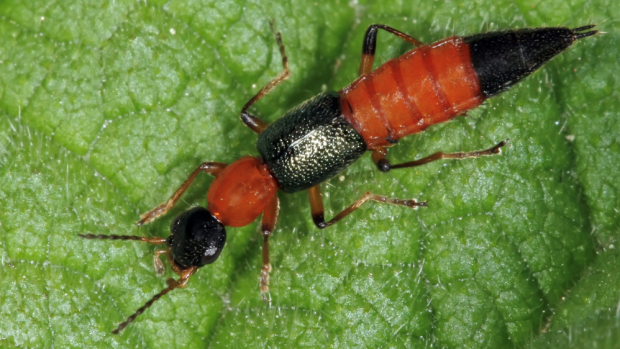A Plague of Egypt appears in the Golden Steppe

This year’s Return of the Wild Horses seemed to be haunted by the ten plagues of Egypt. One of them struck three of my colleagues in the Kazakh steppe.
 It is said that for isolation and characterization of pederin in 1980s it was necessary to collect 25 million of beetles Paederus fuscipes. Today this toxin can be synthesized in laboratory. Photo: Dragiša Savić
It is said that for isolation and characterization of pederin in 1980s it was necessary to collect 25 million of beetles Paederus fuscipes. Today this toxin can be synthesized in laboratory. Photo: Dragiša Savić
Clouds of insects were swarming around the lights in the reintroduction centre in Alibi every evening. All of us were stung, but the abovementioned three colleagues, including the press officer, inadvertently crushed an undefined species of insect under their clothes. This was followed by severe, unremitting pain. They said it was as if someone was burning them with a cigarette. When it finally subsided, for about another fifteen minutes a pain persisted, as if someone was cleaning an open wound with a strong disinfectant. Then necrotic and itchy blisters, which burned and hurt at least for a day, appeared on their skin. These gradually changed over the next few days, but they were extraordinarily and persistently ugly. In two of the three cases the pain intensified again when the blisters burst.
We all saw the originators of this very unpleasant dermatitis in Alibi, although we only identified them as the clear culprits with hindsight. They were about one centimetre long, brightly coloured beetles with shortened elytra—beetles of Paederus genus. Females of some species of this genus contain in their haemolymph toxin pederin, which—when it gets to a skin after crushing the beetle— causes the blisters. By the way, pederin is not produced by the beetles by themselves, but by endosymbiont bacteria, and it has a potential to be beneficial in cancer treatment.
Dermatitis caused by pederin of Paederus beetles can affect you on all continents except Antarctica. And because these beetles can multiply excessively in places with damp soil, sometimes a real epidemy occurs. For example, at an air base in Iraq. Or in a toy factory in China. Or in a new hospital in Sri Lanka… The medical journal Lancet even published a theory that the sixth Plague of Egypt, during which, according to the book Exodus, ugly ulcers broke on Egyptians and their cattle, was caused by Paederus beetles and the pederin they contained. It is possible, as some of the previous plagues could create suitable conditions for their massively multiplying.
Well, in our case the multiplying of Paederus beetles in Alibi was enabled by the second plague, which hit us this year: the floods which inundated the reintroduction centre. After all, the river level was still very high shortly before our arrival, therefore the workers of the centre had to carry the material for repairs of the existing enclosures and construction of the new ones on a boat. The dermatitis of our three colleagues was the last, the tenth plague. But thanks to God they are all doing well and we hope that we had enough of the bad luck even for the next year.
ZOOPRAHA.CZ
Contacts
- The Prague zoological garden
U Trojskeho zamku 120/3
171 00 Praha 7
Phone.: (+420) 296 112 230 (public relations department)
e-mail: zoopraha@zoopraha.cz
Others








